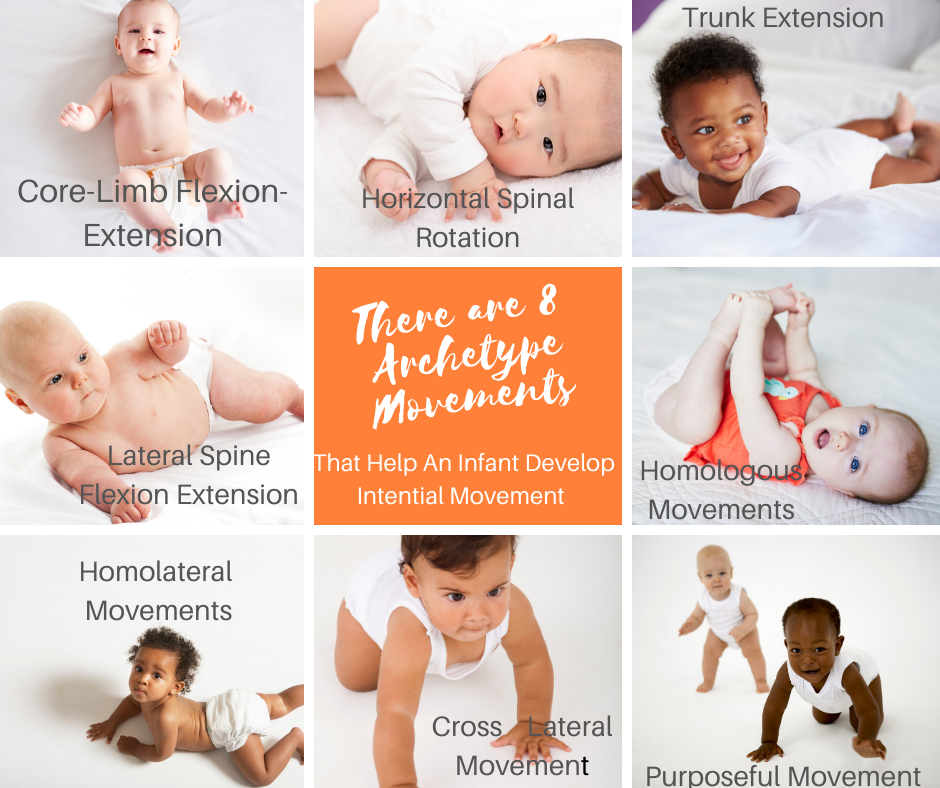I’ve been working with these foundational movements for a couple of years now. While reflexes are about automatically responding to information in our environment, Archetype Movements are the biomechanical patterns that allow our bodies to move and respond. These 7 key movement patterns are found in all of our sensorimotor reflex responses, our automatic motor responses and our consciously controlled motor skills. They develop sequentially in utero; we are born with the innate ability to move through them. By using these patterns over an over, we build strong pathways in the brain that allow us to move with more complex movement patterns leading to skilled, conscious movement and choices.
So these patterns are important! If we haven’t built that strong brain pathway, we start to rely on less efficient motor schemes, we work harder and fatigue easier when we move. These patterns are so important, practicing them daily leads to brain growth that positively impacts learning and regulating our stress responses. The Masgutova Method recognizes 7 Archetype movement patterns and an 8th one that links all of the patterns together for purposeful movement.
1. Core-Limb Flexion Extension or 6 Ended Star: This pattern is about connecting our body center (gravity point) to our head, arms and legs. It allows us to be grounded and sets up the midline of our body. Emotionally it allows our Core Tendon Guard Reflex and Moro Reflex to function appropriately. Finding equilibrium between flexion and extension allows for postural control of the trunk to develop.
2. Horizontal Spine Rotation: Often associated with mouth-spine-rotation as the infant’s head turns toward a food source. As the infant matures other stimuli such as sights and sounds draw their attention and they learn to control the head and rotate toward information. This is foundational for rolling over. The eyes start to track, which is needed later for reading. Rotational movement is also known to improve memory.
3. Trunk Extension: Our genetic code demands that we go upright against gravity, trunk extension is about moving the head upright while stretching the feet downward. Toe walkers are often not able to do this; they are searching for upright without being grounded downward. Trunk extension allows us to organize around our midline, that invisible thread the runs through the middle of our body from our head to our feet. This movement relaxes the tension of the protective reactions of the cerebellum allowing for clarity when thinking. This pattern is the basis of reaching, taking and pushing and is good for awakening before test taking or new learning.
4. Lateral Flexion-Extension: In this pattern one side of our body is flexing to the side simultaneously while the other side is extending. It is the basis for locomotion or being able to stabilize one side of the body while the other is moving. It is needed for tuning over and plays a large role in our ability to move and respond to 12 different reflexes.
5. Homologous (Bilateral) Movement: Here we move both of our arms or both of our legs at the same time. The symmetrical movement is necessary for taking, pulling pushing, raising, etc. The purpose here is to form motor coordination between the right and left limbs such as clapping. By bringing either hands or feet together we gain an inner sense of our bodies midline.
6. Homolateral (Same Side) Movement: This involves the right arm/leg or left arm/leg moving in coordination with each other. The brain begins to access one hemisphere at a time, and dominance of one side starts to emerge. We are free to shift our weight from one side to the other across midline. Differentiated, specialized movements of the limbs develop. The affect of this pattern on learning leads to improved memory, improved motor planning and control, eye-hand coordination, and improved expressive language.
7. Cross-lateral Movement: This is about coordinating movement across body midline and from top to bottom (right arm/left leg or left arm/right leg). It is necessary for crawling, standing up, walking, running, and jumping. All skilled sports use cross lateral movements. It relies on all the other movement patterns to be fully developed. The brain begins to coordinate thinking between the detail oriented, analytic left side and the big picture, gestalt right side.
8. Intentional Movement: This last pattern coordinates all the other patterns together for purposeful, goal-oriented movements like reaching for an object. Intentional movements such as skipping, galloping or hopscotch develops. Movements transition into automatic skills. Precision and controlled movements for manual skills such as writing develop. Cognitively we can set goals, improve our timing and processing speed, as well as improved focus and selective perception.
When these patterns are not working properly, we can re-train the brain and body to bring automaticity, allowing freedom for the body to respond appropriately when reflexes are stimulated. The Masgutova Method has developed simple, repetitive movement exercises that allow the brain to form the strong pathways needed for automaticity and freedom.
One study demonstrated how incorporating these movements into a classroom daily helped to improve reading scores in kindergartners. A friend of mine was trying to complete such a study with a school district using a control group of students who didn’t get the movement intervention. With the introduction of Archetype movements reading scores in the test group improved rapidly. After four months the district suspended the study because they couldn’t justify not providing this movement based intervention to the control group.
These movements are powerful for allowing the brain to organize, which in turn allows for greater learning. Let me know if you want to learn more about them.

